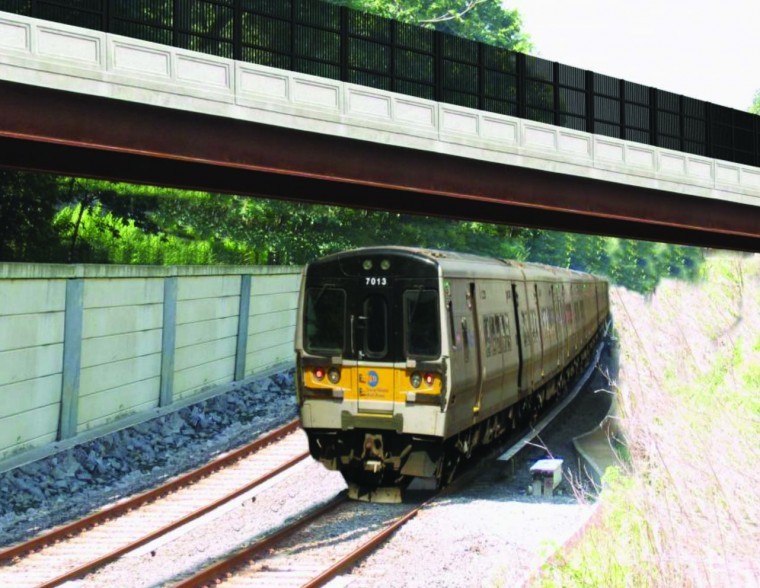It may be a small village in Great Neck, but the Village of Thomaston plays a major role in the Long Island Rail Road’s plans to upgrade the Port Washington line and, ultimately, connect to Grand Central Terminal.
Long Island Rail Road President Helena Williams said Thomaston is key juncture on the Port Washington line because line goes from two tracks to one in Great Neck and there is no other turnaround until a train reaches Port Washington.
“The LIRR is excited for its customers to have east side access into Manhattan,” Williams said. “We need to get the railroad ready to use two terminals and we are identifying track adjustments in order to provide our customers with more trains to Penn Station and Grand Central Terminal.”
The Long Island Rail Road’s plan ran into roadblock last week when Village of Thomaston Mayor Stern and village residents raised concerns about the railroad’s $40 million plan to replace the Colonial Road Bridge and extend an existing pocket track that allows trains to turnaround by 1,200 feet to accommodate a 12-car train. The existing pocket track that allows the LIRR to turn a 10-car train around before Port Washington ends behind the house at 15 Shadow Lane. The proposed pocket track extension of 1,200 feet would reach the intersection of Windsor Road and St. George Road
Stern’s objection at a public meeting at village hall that the extension of the pocket track would impact too many residents, prompting a pointed response from Williams and other LIRR officials who claimed that Stern had been aware of the plan for months and had consistently voiced support.
Williams said a longer pocket track at Great Neck would ensure that more trains would be available on the LIRR’s second busiest branch, increasing service and reliability on the line.
“Immediate access into Grand Central Terminal from Long Island would save commuters 20 minutes to get to work,” Williams said. “We are conscious of Port Washington branch customers because they have high property values and we understand they depend on the LIRR for property values. Faster and more train rides will keep homes on Long Island filled, which is important for the vibrancy of the region.”
The Long Island Rail Road currently stops only on Manhattan’s west side at Penn Station with about half of the rail road’s commuters travel to the east side of Manhattan either by subway or bus after arriving at Penn Station. Williams said the LIRR to add east side access into Grand Central Terminal in 2016.
Williams said in several meetings with public officials Stern only asked that the pocket track be fully landscaped, which she said will take place by planting evergreen and arbor vitae trees at the pocket track.
But at a Nov. 17 meeting at Village Hall in Thomaston with LIRR officials and about 100 Thomaston residents, Stern began the meeting by expressing concern that this project would impact village homeowners.
“I see and understand what the LIRR is trying to do and it is good for the railroad, but bad for the community,” Stern said. “Residents who live near the pocket track now already complain about the noise and extending it further will only annoy more homeowners. I would approve improving service into Manhattan, but don’t want my residents impacted by this project.”
Williams said the pocket track would be used during the morning and evening rush hour commutes and would not be a storage facility to hold trains overnight. Williams said a turn around consists of the engineer performing a brake test to see if the train meets Federal Railroad Administration requirements and does not make any noise, especially since it is located in a deep ravine.
At the Nov. 17 meeting, residents asked the LIRR to think of alternative sites for the pocket track not near their homes. Williams said the LIRR will examine alternative suggestions under federal guidelines of the national environmental procedure that could take five to six months to evaluate.
Williams said Great Neck is a prominent location to extend the pocket track because it has reverse commuters and would provide people with more flexibility and seat opportunities when using the LIRR. She said not having a longer pocket track would only harm LIRR customers who use the Great Neck rail road station.
“If there is no project, service reliability would not increase which would hurt our customers,” Williams said. “We want to increase the number of trains available to our customers if we make improvements, especially those who commute to Great Neck. Not having the pocket track in Great Neck would be a detriment to commuters who begin their trips here.”
Williams said the bridge could not get replaced without extending the pocket track or installing new drainage. The Colonial Road Bridge does not comply with state Department of Transportation sight standards and creates flooding during heavy rainstorms that causes delays on the Port Washington line.
Stern said he has suggestions for the LIRR and is willing to meet with them to discuss the project.
“I would love to talk to them and set up a meeting at anytime,” Stern said. “My residents are unhappy and are not confident the LIRR will listen to them. I will make an effort to present our side and counter their proposal.”
Williams said the LIRR will not move forward with this project until it evaluates all of its alternate suggestions.
“We are trying hard to work with the community to benefit whoever uses the Port Washington line,” Williams said. “We welcome people’s comments and want to hear what they would like us to do. The LIRR will meet with public officials before this project begins.”



